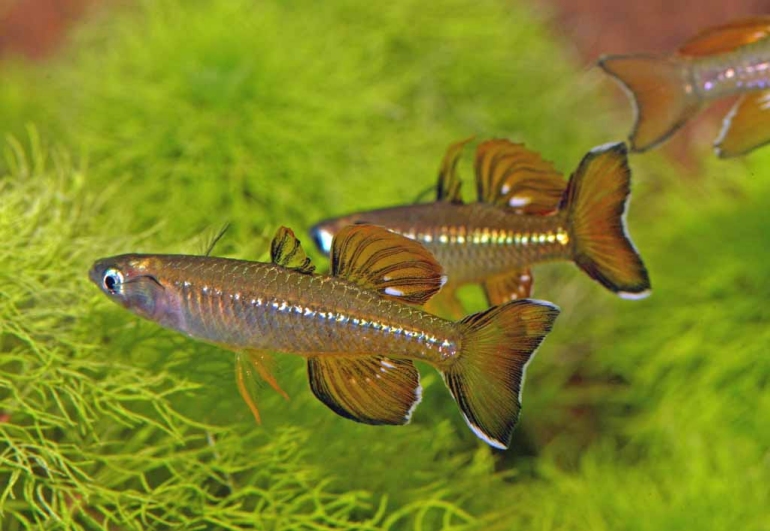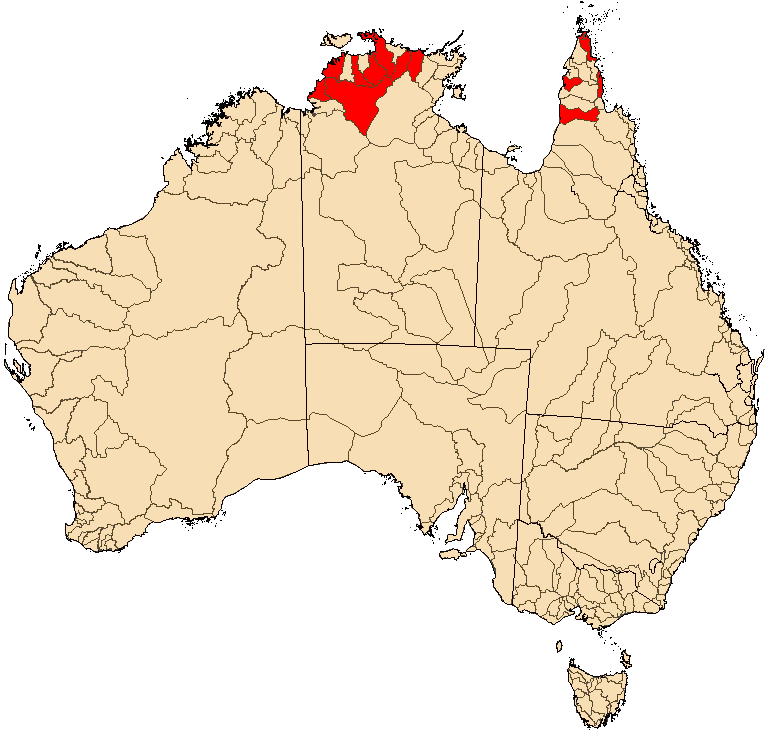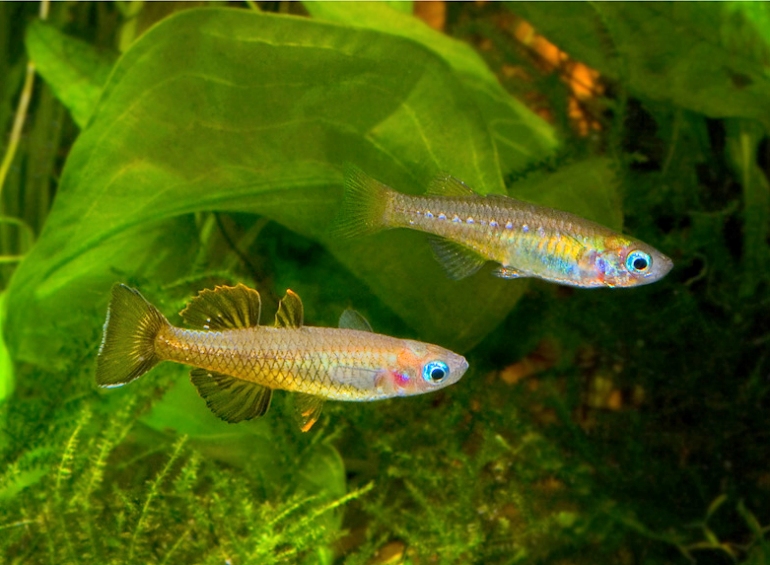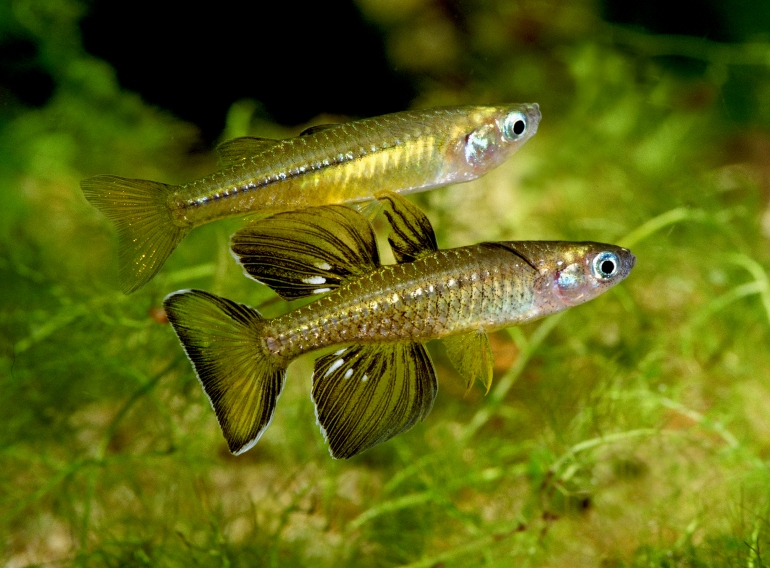|
 |
Pseudomugil tenellus - photo© Dave Wilson |
Taylor, 1964
Delicate Blue-eye
Species Summary
Pseudomugil tenellus is a small fish with a moderately compressed and elongated body; growing to a length of around 4-5 cm. Adult males generally have a translucent golden-brown body colour above the mid-lateral line and yellowish-brown with a silver sheen below. The mid-lateral line consists of a series of discontinuous silvery, reflective scales that become larger in older fish. The body scales are edged in black and form an attractive latticework pattern. They have two dorsal fins, very close together, the first much smaller than the second. The fins have a background colour of golden burnt-orange, with the outer margins light yellow; often edged with white. The second dorsal and anal fins have a semi-circular pattern of several small white spots. The caudal fin has a black margin that is fringed with white. The pectoral fins are fringed along the anterior edge with orange. As the common name suggests, the iris is blue. The operculum and belly region are silvery. However, colour can be variable and will depend upon the mood of the fish, water conditions and diet. Females and juveniles have a similar body colour but not as intense, and have much smaller uncoloured rounded fins with no markings. Females generally have a deeper body than the males whilst the adult males have larger dorsal, anal and pelvic fins. The differences in colour of the body and especially the larger size of the males' fins make the sexes of Pseudomugil tenellus easily distinguishable.
 |
Distribution Map
(Absence from other catchments may reflect a lack of sampling rather than non-existence.) |
Distribution & Habitat
Pseudomugil tenellus was first collected from the East Alligator River near Oenpelli, in the Northern Territory during the American-Australian Scientific Expedition of 1948. They were reportedly abundant in large billabongs and creeks below escarpment waterfalls in the Oenpelli area. However, they were not scientifically described until 1964. They have patchy distribution throughout the northern areas of the Northern Territory, around the Gulf of Carpentaria to Cape York Peninsula in Queensland. In New Guinea they have been found in the Bensbach River and the Aru Islands; although I suspect that their distribution in southern New Guinea will be much wider.
In Australia, Pseudomugil tenellus has been recorded from catchments of the Alligator, Blyth, Daly, Finniss, Howard, Liverpool and Mary river systems in the Northern Territory, where they are commonly found in riverine floodplain billabongs. They have also been collected from Leanyer Swamp, a tidal swamp north-east of Darwin; Rapid Creek, Benjamin Lagoon and a number of other minor streams in the Darwin region. In Queensland they have been collected in the Coleman, Edward, Jardine, Lockhart and Watson river systems; Jacky Jacky and Scrubby Creek (near Coen).
Pseudomugil tenellus have been found inhabiting coastal brackish and fresh waters. They are most common in the lower riverine floodplain swamps and in slow-flowing streams, generally in areas with dense aquatic vegetation. They are usually found in the greatest numbers during the mid-wet season. Juveniles have been collected in all seasons with a peak in the late-wet to early-dry season. Juveniles are mainly found in floodplain billabongs. Larger juveniles can be found in mainchannel waterbodies. Adults are found in essentially the same habitats as the juveniles as well as in the upper reaches of freshwater streams. Both adults and juveniles have been collected in estuary and tidal salt marshes; presumably they can spend their entire lives in these habitats. Water conditions recorded in their natural habitats are: Temperature 27-38°C; pH 5.0-7.1 and Conductivity 6-120 µS/cm. This indicates that this species has a preference for warmer waters.
 |
Pseudomugil tenellus (pair) - photo© Hristo Hristov |
Biology
Pseudomugil tenellus have a generalised diet in their natural habitat feeding opportunistically from the lower and mid-water areas of the waterbodies. The main food items are microcrustaceans, aquatic insects and algae. The identifiable algae were green filamentous and blue-green algae and dinoflagellates. The microcrustaceans were mainly cladocerans, ostracods and copepods. Chironomid larvae were the main aquatic insects eaten. Other food items found in the stomachs were terrestrial insects and miscellaneous organic matter. One study found that the diet in the late-dry season was mainly based on detritus (with associated unidentified organic material) and small quantities of chironomid larvae and pupae, and algae; no microcrustaceans were eaten. In the early-wet season microcrustaceans appeared in the diet and detritus decreased in importance; aquatic insects also appeared in the diet during this season. In the mid-wet season Pseudomugil tenellus consumed mainly microcrustaceans (particularly cladocerans) with smaller amounts of terrestrial and aquatic insects. By the late-wet-early-dry season algae were the main component of the diet.
Pseudomugil tenellus is an egg-scatterer, generally spawning amongst aquatic plants and grasses. Ovaries examined in one study contained 33-45 eggs with a mean diameter of 1.0 mm. However, the number of eggs released at spawning is small, usually between one and five, especially when the females are smaller than 25 mm. The number of eggs shed by a single female is directly related to the size of the female. The total number of eggs released will increase with the maturity and size of the fish. This species seems to prefer to lay their eggs amongst the roots of floating plants such as Ceratopteris thalictroides or any other floating species with fine roots extending into the water.
 |
Pseudomugil tenellus (pair) - photo© Gunther Schmida |
Literature
Allen G.R. (1989) Freshwater fishes of Australia. T.F.H. Publications, Inc., Neptune City, New Jersey.
Allen G.R. (1991) Field guide to the freshwater fishes of New Guinea. Christensen Research Institute, Madang, Papua New Guinea.
Allen G.R., S.H. Midgley and M. Allen (2002) Field guide to the freshwater fishes of Australia. Western Australian Museum, Perth, Western Australia.
Bishop K.A., S.A. Allen, D.A. Pollard and M.G. Cook (2001) Ecological studies on the freshwater fishes of the Alligator Rivers Region, Northern Territory: Autecology. Supervising Scientist Report 145, Supervising Scientist, Darwin.
Dostine P.L. (2003). The fauna of freshwaters in the Darwin Harbour catchment. In 'Proceedings: Darwin Harbour region: Current knowledge and future needs'. Department of Infrastructure, Planning and Environment, Darwin.
Hansen B. (1987) Werneri from the wild. Fishes of Sahul 4(2): 164-168.
Herbert B.W., J.A. Peeters, P.A. Graham and A.E. Hogan (1995) Freshwater Fish and Aquatic Habitat Survey of Cape York Peninsula. (Cape York Peninsula Land Use Strategy) Queensland Department of Primary Industries, Brisbane.
Ivantsoff W., L.E.L.M. Crowley, E. Howe and G. Semple (1988) Biology and early development of eight fish species from the Alligator Rivers Region. Technical memorandum 22, Supervising Scientist for the Alligator Rivers Region, AGPS, Canberra.
Larson H.K. and K.C. Martin (1990) Freshwater Fishes of the Northern Territory. Northern Territory Museum of Arts and Sciences.
Northern Gulf Resource Management Group (2004) Northern Gulf Region Natural Resource Management Plan.
Saeed B., W. Ivantsoff and G.R. Allen (1989) Taxonomic review of the family Pseudomugilidae (Order Atheriniformes). Australian Journal of Marine and Freshwater Research 40: 719-787.
Semple G.P. (1985) Pseudomugil tenellus - maintenance, reproduction and early development of the delicate blue-eye. Fishes of Sahul 3(2): 109-113.
Tappin A.R. (2011) Rainbowfishes - Their Care & Keeping in Captivity. Art Publications, Australia.
Taylor W.R. (1964) Fishes of Arnhem Land. Records of the American-Australian scientific expedition to Arnhem Land. Vol. 4, Zoology edited by R. L. Specht. Volume 4: 45-307, Pls. 1-68.
Adrian R. Tappin
Updated September, 2015



|

